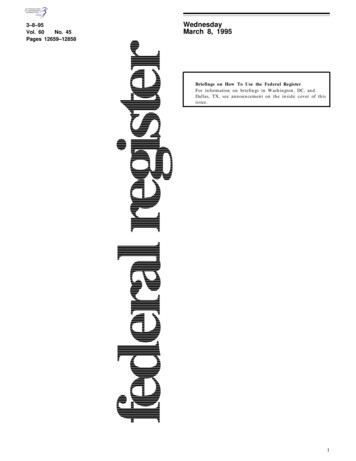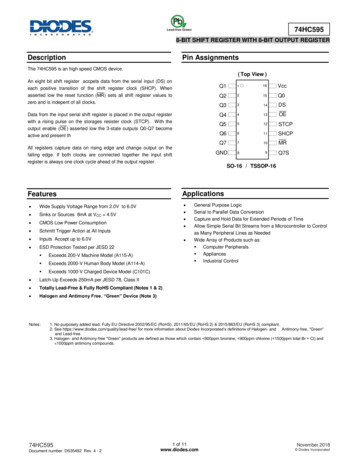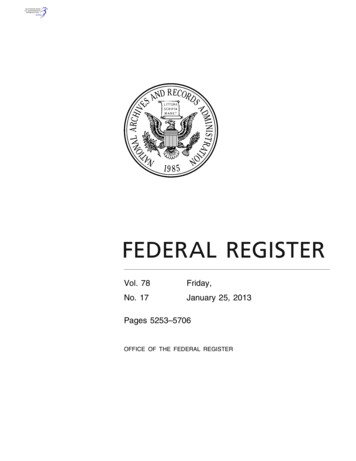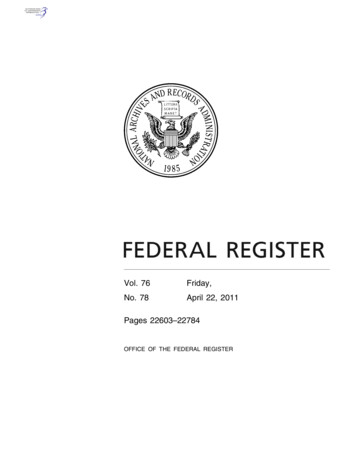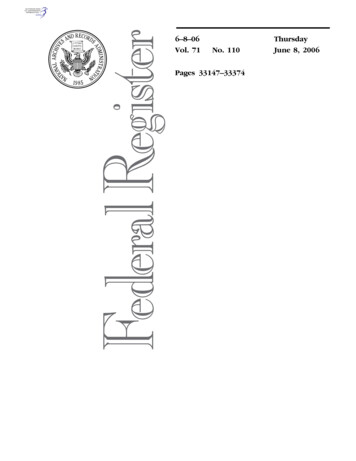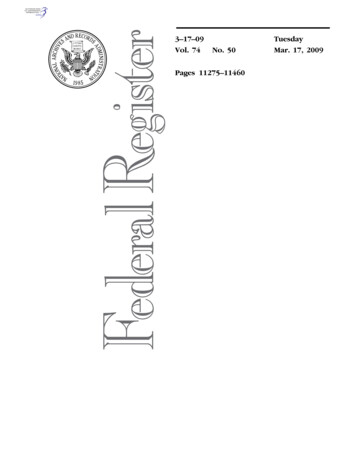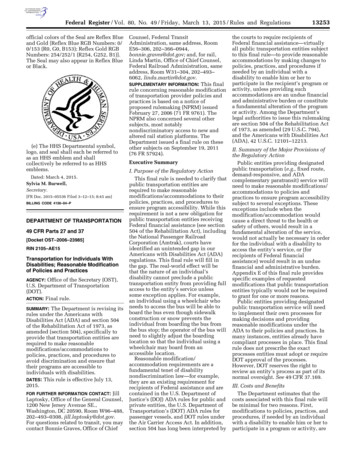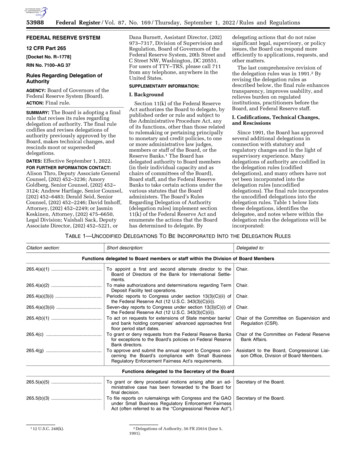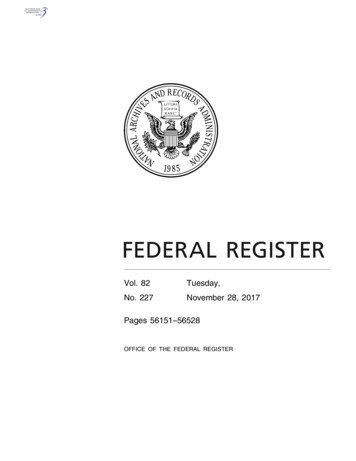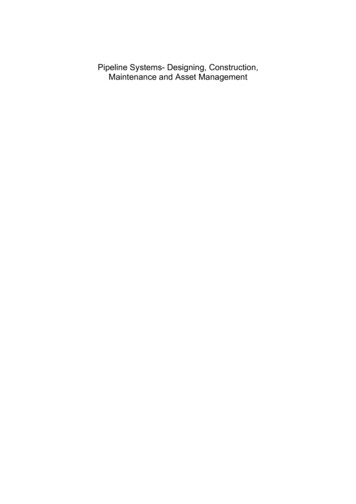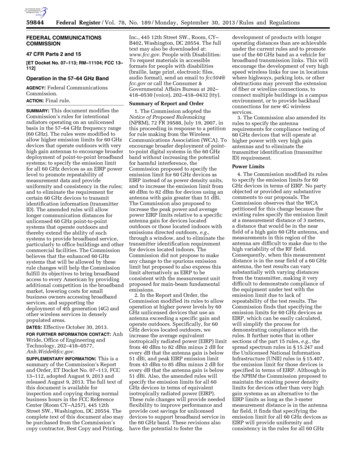
Transcription
59844Federal Register / Vol. 78, No. 189 / Monday, September 30, 2013 / Rules and RegulationsFEDERAL COMMUNICATIONSCOMMISSION47 CFR Parts 2 and 15[ET Docket No. 07–113; RM–11104; FCC 13–112]Operation in the 57–64 GHz BandFederal CommunicationsCommission.ACTION: Final rule.AGENCY:This document modifies theCommission’s rules for intentionalradiators operating on an unlicensedbasis in the 57–64 GHz frequency range(60 GHz). The rules were modified toallow higher emission limits for 60 GHzdevices that operate outdoors with veryhigh gain antennas to encourage broaderdeployment of point-to-point broadbandsystems; to specify the emission limitfor all 60 GHz devices as an EIRP powerlevel to promote repeatability ofmeasurement data and provideuniformity and consistency in the rules;and to eliminate the requirement forcertain 60 GHz devices to transmitidentification information (transmitterID). The amended rules will allowlonger communication distances forunlicensed 60 GHz point-to-pointsystems that operate outdoors andthereby extend the ability of suchsystems to provide broadband service,particularly to office buildings and othercommercial facilities. The Commissionbelieves that the enhanced 60 GHzsystems that will be allowed by theserule changes will help the Commissionfulfill its objectives to bring broadbandaccess to every American by providingadditional competition in the broadbandmarket, lowering costs for smallbusiness owners accessing broadbandservices, and supporting thedeployment of 4th generation (4G) andother wireless services in denselypopulated areas.DATES: Effective October 30, 2013.FOR FURTHER INFORMATION CONTACT: AnhWride, Office of Engineering andTechnology, 202–418–0577,Anh.Wride@fcc.gov.SUPPLEMENTARY INFORMATION: This is asummary of the Commission’s Reportand Order, ET Docket No. 07–113, FCC13–112, adopted August 9, 2013 andreleased August 9, 2013. The full text ofthis document is available forinspection and copying during normalbusiness hours in the FCC ReferenceCenter (Room CY–A257), 445 12thStreet SW., Washington, DC 20554. Thecomplete text of this document also maybe purchased from the Commission’scopy contractor, Best Copy and Printing,mstockstill on DSK4VPTVN1PROD with RULESSUMMARY:VerDate Mar 15 201016:39 Sep 27, 2013Jkt 229001Inc., 445 12th Street SW., Room, CY–B402, Washington, DC 20554. The fulltext may also be downloaded at:www.fcc.gov. People with Disabilities:To request materials in accessibleformats for people with disabilities(braille, large print, electronic files,audio format), send an email to fcc504@fcc.gov or call the Consumer &Governmental Affairs Bureau at 202–418–0530 (voice), 202–418–0432 (tty).Summary of Report and Order1. The Commission adopted theNotice of Proposed Rulemaking(NPRM), 72 FR 39588, July 19, 2007, inthis proceeding in response to a petitionfor rule making from the WirelessCommunications Association (WCA). Toencourage broader deployment of pointto-point digital systems in the 60 GHzband without increasing the potentialfor harmful interference, theCommission proposed to specify theemission limit for 60 GHz devices asEIRP instead of as power density units,and to increase the emission limit from40 dBm to 82 dBm for devices using anantenna with gain greater than 51 dBi.The Commission also proposed toincrease the peak power and averagepower EIRP limits relative to a specificantenna gain for devices locatedoutdoors or those located indoors withemissions directed outdoors, e.g.,through a window, and to eliminate thetransmitter identification requirementfor devices located indoors. TheCommission did not propose to makeany change to the spurious emissionlimit but proposed to also express thislimit alternatively as EIRP to beconsistent with the measurement unitproposed for main-beam fundamentalemissions.2. In the Report and Order, theCommission modified its rules to allowoperation at higher power levels by 60GHz unlicensed devices that use anantenna exceeding a specific gain andoperate outdoors. Specifically, for 60GHz devices located outdoors, weincrease the average equivalentisotropically radiated power (EIRP) limitfrom 40 dBm to 82 dBm minus 2 dB forevery dB that the antenna gain is below51 dBi, and peak EIRP emission limitfrom 43 dBm to 85 dBm minus 2 dB forevery dB that the antenna gain is below51 dBi. Also, the amended rules willspecify the emission limits for all 60GHz devices in terms of equivalentisotropically radiated power (EIRP).These rule changes will provide neededflexibility to improve performance andprovide cost savings for unlicenseddevices to support broadband service inthe 60 GHz band. These revisions alsohave the potential to foster thePO 00000Frm 00070Fmt 4700Sfmt 4700development of products with longeroperating distances than are achievableunder the current rules and to promoteuse of the 60 GHz band as a vehicle forbroadband transmission links. This willencourage the development of very highspeed wireless links for use in locationswhere highways, parking lots, or otherobstructions may prevent the extensionof fiber or wireline connections, toconnect multiple buildings in a campusenvironment, or to provide backhaulconnections for new 4G wirelessservices.3. The Commission also amended itsrules to specify the antennarequirements for compliance testing of60 GHz devices that will operate athigher power with very high gainantennas and to eliminate thetransmitter identification (transmitterID) requirement.Power Limits4. The Commission modified its rulesto specify the emission limits for 60GHz devices in terms of EIRP. No partyobjected or provided any substantivecomments to our proposals. TheCommission observes that the WCApetitioned for this change because theexisting rules specify the emission limitat a measurement distance of 3 meters,a distance that would be in the nearfield of a high gain 60 GHz antenna, andmeasurements in this region of theantenna are difficult to make due to thehigh variability of the RF field.Consequently, when this measurementdistance is in the near field of a 60 GHzantenna, the test results can varysubstantially with varying distancesfrom the transmitter, making it verydifficult to demonstrate compliance ofthe equipment under test with theemission limit due to lack ofrepeatability of the test results. TheCommission finds that specifying theemission limits for 60 GHz devices asEIRP, which can be easily calculated,will simplify the process fordemonstrating compliance with therules. It further notes that in othersections of the part 15 rules, e.g., thespread spectrum rules in § 15.247 andthe Unlicensed National InformationInfrastructure (UNII) rules in § 15.407,the emission limit for those devices isspecified in terms of EIRP. Although inthe NPRM the Commission proposed tomaintain the existing power densitylimits for devices other than very highgain systems as an alternative to theEIRP limits as long as the 3-metermeasurement distance is in the antennafar field, it finds that specifying theemission limit for all 60 GHz devices asEIRP will provide uniformity andconsistency in the rules for all 60 GHzE:\FR\FM\30SER1.SGM30SER1
Federal Register / Vol. 78, No. 189 / Monday, September 30, 2013 / Rules and Regulationsmstockstill on DSK4VPTVN1PROD with RULESdevices, simplify the measurementprocedure, and improve therepeatability of test results.Measurement procedures that have beenfound to be acceptable to theCommission in accordance with § 2.947of our rules may be used to demonstratecompliance.5. The Commission amended§ 15.255(b)(1) of the rules to specifyemission limits for all unlicensed 60GHz devices in terms of EIRP. Because60 GHz devices are already required tobe tested for compliance, this rulechange does not increase the burden oncompliance testing for manufacturersand could facilitate the measurement ofemission levels for both point-to-pointand networking 60 GHz devices whilegreatly improving measurementaccuracy.6. Although the record provides somesupport for the proposals made in theNPRM to increase the average and peakemission limits for transmitters withvery high gain antennas, somecommenters have expressed concernover the potential for window linksusing higher power levels indoors tointerfere with the operation anddeployment of WPAN and otherconsumer devices. The Commissionthus is modifying the rules to allowincreased power for 60 GHz transmittersusing very high gain antennas locatedoutdoors, but it will not apply thesehigher limits to any antenna locatedindoors, including window links.Indoor Devices, Including WindowLinks7. The Commission will continue torequire that all 60 GHz devices usingindoor antennas, including those withemissions directed outdoors as windowlinks, comply with the existing loweremission limits. It notes that our rulesalready permit the use of 60 GHz pointto-point transmitters with a relativelylow-gain antenna (i.e., up to 30 dBi atthe 10W (40 dBm) maximum EIRP, witha transmitter output power of 10 dBm)as window links, and they are now colocated with wireless personal areanetworking (WPAN) devices withoutcausing harmful interference. In mostcases, both types of devices are underthe control of the same party who couldtake steps to eliminate interference, e.g.,by moving one or both devices a shortdistance away from one another.However, the Commission agrees withMotorola that in public locations suchas shopping malls or airports, where a60 GHz point-to-point device and aWPAN network may not be under thesame ownership or otherwise control,the use of higher-power EIRP forwindow links may present concerns andVerDate Mar 15 201016:39 Sep 27, 2013Jkt 229001difficulties in resolving potentialinterference among different equipmentoperators. The Commission furtherobserves that BridgeWave, amanufacturer of point-to-point 60 GHzdevices, has submitted that windowlinks are very rare because officebuilding occupants rarely tolerateindoor mounting of a radio behind awindow. The Commission thusconcludes that window links may notgenerally be needed (or used) to linkone building to another, but if they areused, they must continue to complywith the lower emission limit permittedunder the current rules. Alternatively,operators can link one building toanother by using higher power point-topoint outdoor installations (e.g., fromrooftop to rooftop). In addition, theCommission does not expect that higherpower 60 GHz transmitters using veryhigh gain antennas would be a commoncandidate for residential installationdestined to replace digital subscriberline (DSL) and cable modem broadbandservices, because the high cost of thepoint-to-point devices would precludetheir off-the-shelf retail marketing toconsumers. Therefore, out of abundanceof caution and in view of the limited useof window links as reflected in therecord, the Commission will not permitwindow links to operate at the higherEIRP levels.Outdoor Devices8. Consistent with our proposals inthe NPRM, the Commission modifiedthe rules to adopt an average EIRP limitof 82 dBm and a peak EIRP limit of 85dBm, in each case minus 2 dB for everydB that the antenna gain is below 51dBi, for 60 GHz devices using very highgain antennas that are located outdoors.It finds that this increase in emissionlimits for antennas located outdoors willfacilitate the use of longer range 60 GHzdevices in wireless applications withoutcausing harmful interference toauthorized radio services in this band ordisrupting the operations of otherunlicensed devices, including indoorWPAN systems that currently use thisband. The Commission believes that thischange in the rules will enhance thevalue of the 60 GHz band as a vehiclefor delivering broadband, particularlythe high-capacity backhaul required for4G wireless services. This approach willafford 4G and other broadbandproviders greater operational flexibilityat lower cost by allowing them to useunlicensed devices for backhaul,reserving licensed spectrum for otheruses, thereby promoting spectrumefficiency. Because existing outdoorpoint-to-point 60 GHz devices arerestricted to much lower emissionPO 00000Frm 00071Fmt 4700Sfmt 470059845limits, these changes to our rules wouldprovide tangible benefits, including tosmall businesses and consumers,without additional regulatory costs.9. In the NPRM, the Commissiontentatively concluded that severalfactors will offset any increase in theinterference potential betweenequipment with very high gain antennasand other devices in the 60 GHz band.The Commission noted that: (1) Thevery high gain antennas used would behighly directional, reducing theprobability that a low power,omnidirectional system would belocated within its beamwidth; (2) lowpower devices will operate primarilyindoors because of their shorter range,whereas very high gain directionalsystems will primarily be locatedoutdoors because of their longertransmission range, thus the emissionsfrom directional systems, as seen bylower power indoor devices, will beattenuated significantly fromintervening objects, such as buildingwalls; and (3) oxygen and water vaporabsorption and scattering should furtherreduce ranges at which the radiatedemissions from 60 GHz equipment withvery high-gain antennas could causeinterference.10. The Commission is not persuadedby the opposing commenters from theindoor networking industry that ourpreliminary view is incorrect. TheCommission finds that the highpropagation losses in the 60 GHz bandcombined with the pencil beam of thehigh-gain antennas substantiallymitigate the interference potential ofthese devices. These devices must bevery accurately pointed to a very preciselocation in order to operate effectively.As the antenna gain increases, thebeamwidth of the antenna becomesnarrower, making it less likely that thesedevices will cause interference tonearby receivers unless they are locateddirectly in the path of this pencil-thinantenna beam. In this regard, theCommission observes that in order tokeep a link with a high gain antennaoperating, the transmitter and receivermust be aligned using a specialalignment tool, so that the likelihood ofinadvertent transmission through such awindow is remote. Because of the highlydirectional nature of 60 GHz point-topoint communications, if the link weremisaligned and the transmitter’s signalswould be mistakenly directed toward areceiver other than its intended receiver,the communication link itself would bebroken (transmission terminated) andrealignment would be required toreestablish the link.11. Additional factors furtherdiscount the likelihood of harmfulE:\FR\FM\30SER1.SGM30SER1
mstockstill on DSK4VPTVN1PROD with RULES59846Federal Register / Vol. 78, No. 189 / Monday, September 30, 2013 / Rules and Regulationsinterference, as suggested by theInstitute of Electrical and ElectronicsEngineers (IEEE) 802.18 RadioTechnical Advisory Group (IEEE RR–TAG), from an outdoor high-powerremotely-mounted transmitter (e.g.,mounted on the roof of an adjacentbuilding, on a balcony, or under a roofoverhang) that may inadvertentlytransmit radiation into the window of aroom where a WPAN receiver may beoperating. One is the geographicseparation between higher power pointto-point outdoor installations and lowpower indoor WPAN networks. Thisfactor is significant because of the veryshort range associated with 60 GHzdevices (touted as a benefit bymanufacturers of both outdoor andindoor consumer products in light of itssecurity advantages). IEEE RR–TAG alsofails to address the effects ofattenuation. Even if a small portion ofthe emission from a high gain outdoorantenna were to enter into a roomthrough a window, that low-levelemission would first be attenuated bythe glass, before being further attenuatedby other objects in the room, thusminimizing its potential interferenceeffect significantly. For all thesereasons, and absent any record evidenceto the contrary, it is our predictivejudgment that the proposed change aslimited to outdoor devices would notresult in harmful interference, which isdefined not to protect against isolatedoccurrences, but only againstinterference that ‘‘seriously degrades,obstructs, or repeatedly interrupts’’ aradio communication service.12. The Commission also decline toadopt the IEEE RR–TAG’srecommendations for measuring nearbybuildings’ perimeter power density andfor adopting an automatic transmitpower control to limit the maximumpower at the receiver end of a point-topoint link. The Commission finds suchrequirements unnecessary for coexistence between indoor and outdoorunlicensed devices in this band becauseof the high signal propagation losses atthese frequencies and the highly narrowbeamwidth of the outdoor devices;furthermore, the IEEE RR–TAG did notsupport its recommendations with anyspecific interference data. In response toIEEE RR–TAG comments, Motorolarecommends that, absent more specificdata and justification, the Commissionsimply limit use to the minimum powernecessary to complete the link inaccordance with good engineeringprinciples and require that all point-topoint devices have the ability to adjustpower output downward. TheCommission agrees with Motorola that itVerDate Mar 15 201016:39 Sep 27, 2013Jkt 229001should not require the IEEErecommended limitations without moredata and justification. However, theCommission finds that the power at anindividual location can be adjusted byantenna selection therefore, it is notnecessary to require that the ability toadjust power output be built into thetransmitter, which would add costwithout countervailing benefit. TheCommission also notes that both the 60GHz outdoor and indoor equipment areunlicensed devices that do not havepriority rights to the spectrum over oneanother; however, the geographicalseparation of the two types ofequipment will eliminate any potentialof harmful interference.13. Finally, the Commission observesthat since the adoption of the NPRM,there has been ample time for SpaceFrequency Coordination Group (SFCG)to conduct its studies regarding theEarth Exploration Satellite Service(EESS). Further, the Commission doesnot maintain the specific data on 60GHz devices as requested by SFCG,other than the information submitted inthe device certification applications,which can be accessed through ourpublic equipment authorizationdatabase. In addition, the Commissionagrees with Motorola that the potentialfor interference to EESS is sufficientlylow such that the need for additionalstudy does not warrant a delay in ourdecision. The Commission finds that thehigh-gain antennas with very narrowbeam widths employed by 60 GHzdevices operating under the new higherEIRP limits, combined with theatmospheric attenuation and severepropagation losses at these frequencieswill limit any potential for interferenceto EESS and that sharing of this servicewith 60 GHz devices at higher EIRPlimits will not be a cause for concern.Antenna Substitution14. Section 15.204(c)(4) of the rulesallows intentional radiators to bemarketed and used with any antennathat is of the same type and of equal orless directional gain as the antennaauthorized with the equipment.Manufacturers must provide a list ofacceptable antenna types with anapplication for equipmentauthorization, and the Commission doesnot require retesting of a systemconfiguration that uses an antenna thatis the same type and with equal or lessdirectional gain than the one itauthorizes.15. The Commission concludes that60 GHz devices that will operateoutdoors under the higher EIRP limits itis adopting herein should be authorizedfor operation using only the specificPO 00000Frm 00072Fmt 4700Sfmt 4700antenna(s) with which the system willbe marketed and operated. In particular,as proposed in the NPRM, theCommission will require thatcompliance testing be performed usingthe highest gain and the lowest gainantennas for which certification is beingsought, rather than testing only thehighest gain antenna for each antennatype as permitted by § 15.204(c). TheCommission finds that testing of bothhighest and lowest gain antennas isnecessary given that our rules will allowthe EIRP to vary relative to the antennagain, thus ensuring compliance with ouremission and RF exposure limits. It willcontinue to require, as also proposed inthe NPRM, that compliance testing beperformed with the 60 GHz intentionalradiator operated at its maximumavailable output power level and thatthe applicant for equipment certificationprovides a list of acceptable antennaswith its application. Accordingly, theCommission is amending§ 15.255(b)(1)(ii) to specify the aboveantenna requirements for the higherpower 60 GHz transmitters. Because 60GHz devices are already required to betested for compliance with all the typesof antennas that are intended to be usedwith the equipment and to submit theworst-case results in the application forcertification, the additional regulatorycost of providing information on anadditional test result already required tobe performed by our rules is notsignificant.Spurious Emissions16. Spurious emissions are thoseemissions on a frequency outside thenecessary bandwidth, the level of whichmay be reduced without affecting thetransmission of information. Section15.255(c)(3) requires that 60 GHzequipment spurious emissions between40 GHz and 200 GHz be limited to 90pW/cm2 at a distance of 3 meters, whichis equivalent to an EIRP level of 10dBm. In the NPRM, the Commissionproposed to retain the existing limits onspurious emissions but clarified in theproposed rule § 15.255(c)(3) thatmeasurements must be made in the farfield and that if the far field distance isgreater than 3 meters, then themeasurement results would need to beextrapolated to a distance of 3 metersaccording to § 15.31(f)(1).17. The Commission declined toadopt the clarification proposed in theNPRM with regard to the measurementdistance with respect to spuriousemissions. In the NPRM, theCommission proposed to express thislimit alternatively as EIRP to beconsistent with the measurement unitproposed for main-beam fundamentalE:\FR\FM\30SER1.SGM30SER1
mstockstill on DSK4VPTVN1PROD with RULESFederal Register / Vol. 78, No. 189 / Monday, September 30, 2013 / Rules and Regulationsemissions. BridgeWave’s commentsclearly indicate a presumption that theCommission has somehow proposed tomodify the spurious emission limits,which was never intended. TheCommission therefore finds that itwould be less confusing to maintain theexisting spurious emission rule with thelimit expressed in power density units,rather than EIRP, and it will make nochanges to § 15.255(c)(3).18. With respect to BridgeWave’srequest for an increase in spuriousemission limit, the Commission notesthat it is not making any changes to thespurious emission limit. Thus, it findsthat the concerns expressed byBridgeWave about increased filteringrequirements are not warranted, andlikewise there is no reason for us toconsider increasing the spuriousemission limits as BridgeWave suggests.19. With regard to the radioastronomy service and National RadioAstronomy Observatory (NRAO)concerns, the Commission observed atthe outset that, although the NPRMproposed to increase the average EIRPpower limit, it proposed to limit peakemission levels, and also ‘‘to retain theexisting limits on spurious emissionsand peak transmitter output power.’’The Commission’s intention here was toseek comment on a proposal to maintainthe appropriate power limit itself (i.e.,in the case of spurious emissions, theexisting 90 pW/cm2 limit), not onwhether to extend that limit toadditional frequency bands or to limitthe frequency range of operations for 60GHz devices. Thus, the Commissiondoes not believe it is appropriate to takeeither of these actions here. In anyevent, however, the Commission notesthat because it has not increased thespurious emission limit or reduced thefrequency range of measurements(presently 200 GHz) for 60 GHz devices,there is no higher risk of interferencefrom spurious emissions than thatwhich is presently allowed. Moreover,spurious and harmonic emissionstypically roll off (i.e., reduce inamplitude) the further they are infrequency from the fundamentalemission. Thus, harmonic emissions atthe fourth harmonic—produced by thefundamental frequencies at 56.5–57.88GHz and arising in the RAS band at226–231.5 GHz—would be expected tobe significantly lower than those alreadydeemed to be acceptable at the thirdharmonic of these fundamentalfrequencies which are constrained bythe present measurement cutoff.Similarly, spurious emissions generatedby these devices at the 226–231.5 GHzfrequencies in the RAS band would notbe expected to be greater than thoseVerDate Mar 15 201016:39 Sep 27, 2013Jkt 229001below 200 GHz (the top of the specifiedrange). Further, while there isconsiderable difference in theatmospheric attenuation between 60GHz and 231.5 GHz as claimed byNRAO, the difference in atmosphericattenuation between 200 GHz and 231.5GHz is not significant and thus wouldnot affect our conclusion. In fact, nearlyall of the RAS allocations for whichNRAO expresses concern were madebefore the implementation of unlicenseddevices in § 15.255 of our rules, andunlicensed 60 GHz devices have beensuccessfully sharing spectrum with RASwithout causing harmful interference.Further, NRAO provides no informationor specific analysis of potential harmfulinterference from 60 GHz devices toradio astronomy service.20. Consistent with this experience,the Commission finds that interferenceto Radio Astronomy Service (RAS)stations is unlikely. First, RAS receiversdiscriminate against off-axis signals.Second, such receivers are typicallylocated in rural areas, not the urbanareas where outdoor point-to-point 60GHz devices are likely to be found.Third, the severe propagation losses ofRF signals in the 60 GHz band due tooxygen absorption and atmosphericconditions, and the highly focused anddirectional emissions of 60 GHz deviceslimit any potential for interference fromfundamental emissions to RAS such thatthe Commission does not believe thatsharing of this service with 60 GHzdevices at higher EIRP levels is a causefor concern. It also does not find that theeffect of harmonic and other spuriousemissions from 60 GHz devices warrantsan extension of the upper frequencyband placed on spurious emissions of60 GHz devices, because as wediscussed, the difference in atmosphericattenuation between 200 GHz and 231.5GHz is not significant enough to affectthe acceptable level of emissions fromboth spurious and harmonic emissionsensured by operation of our existingrules. In addition, as noted, theCommission finds that NRAO’s requestto exclude part 15 operations from theentire 57–58 GHz band is outside of thescope of this proceeding. As for NRAO’srequest for a geographical separationzone around specific RAS sites, theCommission notes that in permitting the57–64 GHz band to be used forunlicensed operations, it has alreadytaken into account the 182–185 GHzRAS band, when it adopted the presentspurious emission limit, and theCommission is keeping this limit thesame, even though it allows higherfundamental emission limits, therebyproviding the same protection to RASPO 00000Frm 00073Fmt 4700Sfmt 470059847frequencies as if the fundamental levelsare unchanged from existing rules. TheCommission therefore denies NRAO’srequest.Transmitter ID21. Section 15.255(i) of the rulesrequires that 60 GHz unlicensedemissions that emanate inside abuilding include a transmitter ID inorder to permit users experiencinginterference from indoor wireless localarea network (LAN) devices to moreaccurately identify the source of theinterference; this transmitter ID mustindicate the manufacturer and type ofeach unit of equipment. Thisrequirement does not apply to deviceswith transmitting antennas locatedoutdoors. In the NPRM, the Commissionproposed to eliminate the transmitter IDrequirement for any indoor deviceswhose emissions are directed outdoors,e.g., through a window. TheCommission stated that any interferencepotential likely will be localized arounda window link, and it is more likely thatany 60 GHz emissions that are reflectedfrom the glass in a window link will beattenuated by the walls and othersurrounding objects and will not impactoperations in adjacent areas. TheCommission also sought comment onwhether the transmitter ID requirementshould be eliminated for all 60 GHzsystems, as the proximity of indoor colocated equipment should allow theuser to identify the interferingtransmitter to other indoor deviceswithout having to use this feature.22. The Commission is modifying therules to eliminate the transmitter IDrequirement for all 60 GHz devices.Cisco has urged the Commission toconsider the work of multiple standardsbodies in its deliberations. TheCommission observes that since therelease of the NPRM, industry standardshave been adopted for indoor 60 GHzWPAN devices which provide moreefficient and cost-effective interferenceavoidance techniques, such aschannelization, carrier sense multipleaccess with collision avoidance (CSMA/CA), beacon frames, etc. Thesetechniques are similar to thoseimplemented by wireless networkingproducts operating in the crowdedregion of 2.4 GHz or 5.8 GHzfrequencies where WPAN devices mustco-exist with other WPAN devices aswell. The Commission finds that, withthese technological advances, coexistence between these 60 GHz devicesis better resolved by voluntary standardsthan by a transmitter identificationrequirement. Except for Cisco’s concern(which also reflects questions abouthigher power indoor devices that theE:\FR\FM\30SER1.SGM30SER1
59848Federal Register / Vol. 78, No. 189 / Monday, September 30, 2013 / Rules and RegulationsCommission has declined to permit), therecord in this proceeding provides nosupport for retaining this requirement.The Commission’s decision to limithigher power EIRP transmitters tooutdoor applications and the factors inour assessment of the interferencepotential from window links aboveshould alleviate Cisco’s and the WPANindustry’s concerns, while eliminationof
field and that if the far field distance is greater than 3 meters, then the measurement results would need to be extrapolated to a distance of 3 meters according to §15.31(f)(1). 17. The Commission declined to adopt the clarification proposed in the NPRM with regard to the measurement distance with respect to spurious emissions. In the NPRM, the
